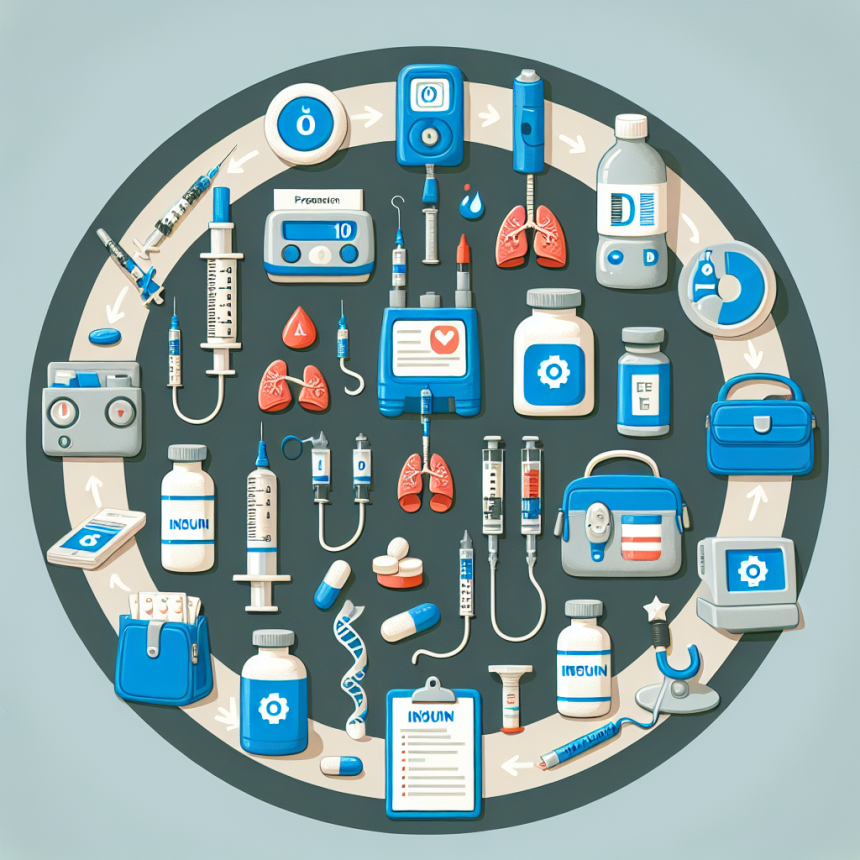-
Table of Contents
«Controla tu diabetes con Insulina: un ciclo completo a un precio accesible»
Introduction
Un ciclo completo con insulina es un tratamiento médico utilizado para controlar los niveles de azúcar en la sangre en personas con diabetes. Este tratamiento consiste en la administración de insulina, una hormona que ayuda a regular los niveles de glucosa en el cuerpo. El costo de un ciclo completo con insulina puede variar dependiendo de varios factores, como la dosis necesaria, el tipo de insulina utilizada y la frecuencia de administración. En general, el costo puede ser significativo, pero es importante recordar que la insulina es esencial para el manejo adecuado de la diabetes y puede ayudar a prevenir complicaciones graves.
The Cost of a Complete Insulin Cycle: Understanding the Expenses Involved
Insulin is a vital medication for individuals with diabetes, a chronic condition that affects millions of people worldwide. It is a hormone that helps regulate blood sugar levels and is essential for the body’s proper functioning. For those who require insulin, it is a lifeline that allows them to manage their condition and live a healthy life. However, the cost of insulin can be a significant burden for many individuals and families. In this article, we will explore the expenses involved in a complete insulin cycle and provide insights into how to manage these costs.
The first expense to consider is the cost of insulin itself. The price of insulin can vary significantly depending on the type and brand. There are three main types of insulin: rapid-acting, short-acting, and long-acting. Rapid-acting insulin, such as Humalog and Novolog, is the most expensive, with an average cost of $300 for a 10ml vial. Short-acting insulin, such as Regular and Humulin R, is slightly cheaper, with an average cost of $150 for a 10ml vial. Long-acting insulin, such as Lantus and Levemir, is the most affordable, with an average cost of $100 for a 10ml vial. However, these prices can vary depending on the pharmacy and insurance coverage.
In addition to the cost of insulin, there are other expenses involved in a complete insulin cycle. One of the most significant expenses is the cost of blood glucose testing supplies. People with diabetes need to monitor their blood sugar levels regularly, and this requires test strips, lancets, and a glucose meter. The average cost of a glucose meter is $20 to $40, while a box of 100 test strips can cost anywhere from $50 to $100. Lancets, which are used to prick the finger for blood samples, can cost around $10 for a box of 100. These costs can add up quickly, especially for those who need to test their blood sugar multiple times a day.
Another expense to consider is the cost of syringes or insulin pens. These are used to administer insulin and need to be replaced regularly. The cost of syringes can range from $10 to $20 for a pack of 100, while insulin pens can cost anywhere from $25 to $50 each. Some insurance plans may cover the cost of these supplies, but it is essential to check with your provider to understand your coverage.
Aside from the direct costs of insulin and supplies, there are also indirect expenses to consider. For example, individuals with diabetes may need to make lifestyle changes, such as following a specific diet or incorporating regular exercise, to manage their condition. These changes may require additional expenses, such as purchasing healthier food options or joining a gym. Additionally, people with diabetes may need to visit their healthcare provider more frequently, which can result in additional co-pays or deductibles.
Managing the costs of a complete insulin cycle can be challenging, but there are ways to reduce expenses. One option is to explore generic versions of insulin, which can be significantly cheaper than brand-name insulin. Another option is to look into patient assistance programs offered by pharmaceutical companies, which can provide discounts or even free insulin to those who qualify. It is also essential to review your insurance coverage and understand what is covered and what is not. Some insurance plans may have a preferred brand of insulin, which can result in lower costs for the patient.
In conclusion, the cost of a complete insulin cycle can be a significant financial burden for individuals with diabetes. The price of insulin, blood glucose testing supplies, and other related expenses can add up quickly. However, by exploring different options and understanding insurance coverage, it is possible to manage these costs effectively. It is also essential to communicate with your healthcare provider and pharmacist to find the most cost-effective solutions for your specific needs. With proper management and support, individuals with diabetes can continue to access the insulin they need to live a healthy and fulfilling life.
Breaking Down the Expenses of a Full Insulin Cycle: What to Expect
Insulin is a vital medication for individuals with diabetes, as it helps regulate blood sugar levels and prevent serious health complications. However, the cost of insulin can be a major concern for those who rely on it for their daily health management. In this article, we will break down the expenses of a full insulin cycle and provide insight into what to expect when it comes to the cost of this life-saving medication.
First and foremost, it is important to understand that the cost of insulin can vary greatly depending on a variety of factors. These factors include the type of insulin, the brand, the dosage, and the method of administration. Additionally, the cost can also vary depending on where you live and the type of insurance coverage you have. Therefore, it is crucial to consult with your healthcare provider and insurance company to get a better understanding of the specific costs for your individual situation.
The first expense to consider when it comes to a full insulin cycle is the initial prescription. This is the cost of the insulin itself, which can range from $25 to $500 per vial or pen, depending on the type and brand. For example, a vial of Humalog, a fast-acting insulin, can cost around $300, while a vial of Lantus, a long-acting insulin, can cost around $350. These prices may seem high, but it is important to note that a vial or pen can last for several weeks, depending on the dosage prescribed by your doctor.
In addition to the cost of the insulin, there are also other necessary supplies that are needed for a full insulin cycle. These include syringes, needles, and alcohol swabs. The cost of these supplies can range from $10 to $50 per month, depending on the frequency of insulin injections and the type of supplies needed. Some insurance plans may cover the cost of these supplies, but it is important to check with your provider to confirm coverage.
Another expense to consider is the cost of blood sugar monitoring. Individuals with diabetes need to regularly check their blood sugar levels to ensure they are within a healthy range. This requires the use of a blood glucose meter, which can cost anywhere from $20 to $100. Additionally, the cost of test strips, which are used with the meter, can range from $20 to $100 per month, depending on the frequency of testing. Again, it is important to check with your insurance provider to see if these costs are covered.
Furthermore, it is important to factor in the cost of doctor visits and lab tests. Individuals with diabetes need to regularly visit their healthcare provider to monitor their condition and adjust their insulin dosage if necessary. These visits can cost anywhere from $50 to $200, depending on the type of doctor and location. Additionally, lab tests, such as A1C tests, which measure average blood sugar levels over a period of time, can cost around $50 to $100.
Lastly, it is important to consider the cost of potential complications that may arise from diabetes. If blood sugar levels are not properly managed, individuals with diabetes may experience serious health complications, such as nerve damage, kidney disease, and heart disease. These complications can result in additional medical expenses, including hospital stays, surgeries, and medications. Therefore, it is crucial to prioritize proper insulin management to prevent these costly complications.
In conclusion, the cost of a full insulin cycle can vary greatly depending on a variety of factors. It is important to consult with your healthcare provider and insurance company to get a better understanding of the specific costs for your individual situation. Additionally, it is important to prioritize proper insulin management to prevent potential complications and additional medical expenses. With proper planning and management, individuals with diabetes can effectively manage the cost of their insulin and maintain a healthy lifestyle.
Budgeting for a Complete Insulin Cycle: Tips and Strategies for Managing Costs
Insulin is a crucial medication for individuals with diabetes, as it helps regulate blood sugar levels and prevent serious health complications. However, the cost of insulin can be a major concern for those who rely on it for their daily health management. In this article, we will discuss the average cost of a complete insulin cycle and provide tips and strategies for managing these expenses.
The cost of insulin can vary greatly depending on factors such as the type of insulin, dosage, and insurance coverage. On average, a vial of insulin can cost anywhere from $25 to $300, with some newer and more advanced types of insulin reaching prices of over $500 per vial. For those who require multiple vials per month, the cost can quickly add up and become a significant financial burden.
One way to manage the cost of insulin is to explore different types of insulin and their corresponding prices. Traditional human insulin, which has been on the market for decades, tends to be less expensive compared to newer types of insulin such as analog insulin. However, analog insulin may offer better blood sugar control and fewer side effects for some individuals. It is important to consult with a healthcare provider to determine the most suitable type of insulin for your specific needs.
Another factor that can impact the cost of insulin is the dosage. The amount of insulin needed can vary greatly from person to person, and it is essential to work closely with a healthcare provider to determine the appropriate dosage. Taking more insulin than necessary can lead to wasted medication and unnecessary expenses. On the other hand, taking too little insulin can result in uncontrolled blood sugar levels and potential health complications. By carefully monitoring blood sugar levels and adjusting the dosage accordingly, individuals can avoid unnecessary costs and ensure proper management of their diabetes.
Insurance coverage is also a crucial aspect to consider when budgeting for a complete insulin cycle. Many insurance plans cover the cost of insulin, but the coverage may vary depending on the type of plan and the specific insulin prescribed. It is essential to review insurance coverage and understand any out-of-pocket costs, such as deductibles and copayments. For those without insurance coverage, there are programs available that offer discounted or even free insulin for those who qualify based on income and other criteria.
In addition to exploring different types of insulin and insurance coverage, there are other strategies that individuals can use to manage the cost of a complete insulin cycle. One option is to purchase insulin in bulk, which can often result in a lower cost per vial. However, it is crucial to check the expiration date and storage requirements to ensure the insulin remains effective. Another strategy is to switch to a generic brand of insulin, which can be significantly less expensive than brand-name insulin. It is important to consult with a healthcare provider before making any changes to insulin brands.
Furthermore, it is essential to properly store insulin to maintain its effectiveness and avoid unnecessary waste. Insulin should be stored in a cool, dry place and should not be exposed to extreme temperatures. It is also important to check the expiration date and discard any expired insulin. By properly storing and managing insulin, individuals can avoid the need for frequent replacements and save on costs.
In conclusion, the cost of a complete insulin cycle can vary greatly depending on various factors. By exploring different types of insulin, monitoring dosage, understanding insurance coverage, and implementing cost-saving strategies, individuals can effectively manage the expenses associated with insulin. It is also crucial to work closely with a healthcare provider to ensure proper management of diabetes and avoid any potential health complications. With careful planning and budgeting, individuals can successfully navigate the financial aspect of a complete insulin cycle and focus on maintaining their overall health and well-being.
Q&A
1) ¿Cuánto cuesta un ciclo completo con Insulina?
El costo de un ciclo completo con Insulina puede variar dependiendo del tipo de insulina, la dosis y la duración del tratamiento. En general, puede oscilar entre $50 y $500 dólares por mes.
2) ¿Existen opciones más económicas para el tratamiento con Insulina?
Sí, existen opciones más económicas para el tratamiento con Insulina, como por ejemplo utilizar insulinas genéricas o buscar programas de asistencia financiera ofrecidos por compañías farmacéuticas.
3) ¿Qué factores pueden afectar el costo de un ciclo completo con Insulina?
Además de los mencionados anteriormente, otros factores que pueden afectar el costo de un ciclo completo con Insulina incluyen la cobertura de seguro médico, la frecuencia de uso de la insulina y la necesidad de otros medicamentos o suministros para el tratamiento de la diabetes. También puede variar dependiendo del país o región en la que se encuentre.




